Wojciech Matusik
Inkbit, USA, CSAIL, MIT, USA
Two-Stage Pretraining for Molecular Property Prediction in the Wild
Nov 05, 2024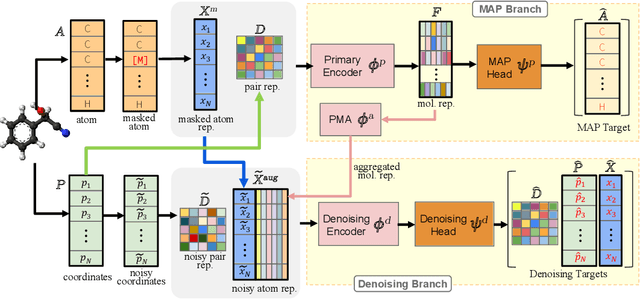

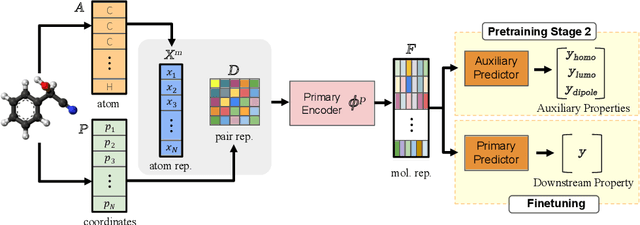

Abstract:Accurate property prediction is crucial for accelerating the discovery of new molecules. Although deep learning models have achieved remarkable success, their performance often relies on large amounts of labeled data that are expensive and time-consuming to obtain. Thus, there is a growing need for models that can perform well with limited experimentally-validated data. In this work, we introduce MoleVers, a versatile pretrained model designed for various types of molecular property prediction in the wild, i.e., where experimentally-validated molecular property labels are scarce. MoleVers adopts a two-stage pretraining strategy. In the first stage, the model learns molecular representations from large unlabeled datasets via masked atom prediction and dynamic denoising, a novel task enabled by a new branching encoder architecture. In the second stage, MoleVers is further pretrained using auxiliary labels obtained with inexpensive computational methods, enabling supervised learning without the need for costly experimental data. This two-stage framework allows MoleVers to learn representations that generalize effectively across various downstream datasets. We evaluate MoleVers on a new benchmark comprising 22 molecular datasets with diverse types of properties, the majority of which contain 50 or fewer training labels reflecting real-world conditions. MoleVers achieves state-of-the-art results on 20 out of the 22 datasets, and ranks second among the remaining two, highlighting its ability to bridge the gap between data-hungry models and real-world conditions where practically-useful labels are scarce.
Sensor2Text: Enabling Natural Language Interactions for Daily Activity Tracking Using Wearable Sensors
Oct 26, 2024Abstract:Visual Question-Answering, a technology that generates textual responses from an image and natural language question, has progressed significantly. Notably, it can aid in tracking and inquiring about daily activities, crucial in healthcare monitoring, especially for elderly patients or those with memory disabilities. However, video poses privacy concerns and has a limited field of view. This paper presents Sensor2Text, a model proficient in tracking daily activities and engaging in conversations using wearable sensors. The approach outlined here tackles several challenges, including low information density in wearable sensor data, insufficiency of single wearable sensors in human activities recognition, and model's limited capacity for Question-Answering and interactive conversations. To resolve these obstacles, transfer learning and student-teacher networks are utilized to leverage knowledge from visual-language models. Additionally, an encoder-decoder neural network model is devised to jointly process language and sensor data for conversational purposes. Furthermore, Large Language Models are also utilized to enable interactive capabilities. The model showcases the ability to identify human activities and engage in Q\&A dialogues using various wearable sensor modalities. It performs comparably to or better than existing visual-language models in both captioning and conversational tasks. To our knowledge, this represents the first model capable of conversing about wearable sensor data, offering an innovative approach to daily activity tracking that addresses privacy and field-of-view limitations associated with current vision-based solutions.
Multimodal Large Language Models for Inverse Molecular Design with Retrosynthetic Planning
Oct 05, 2024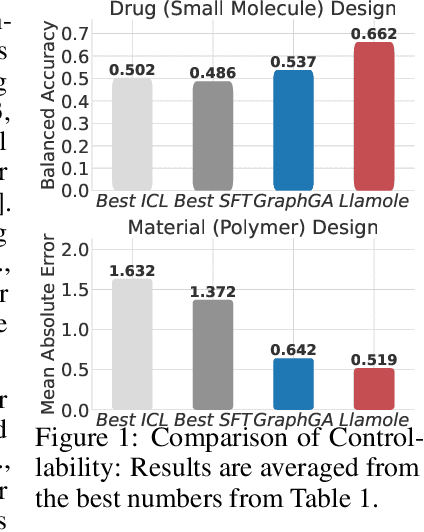
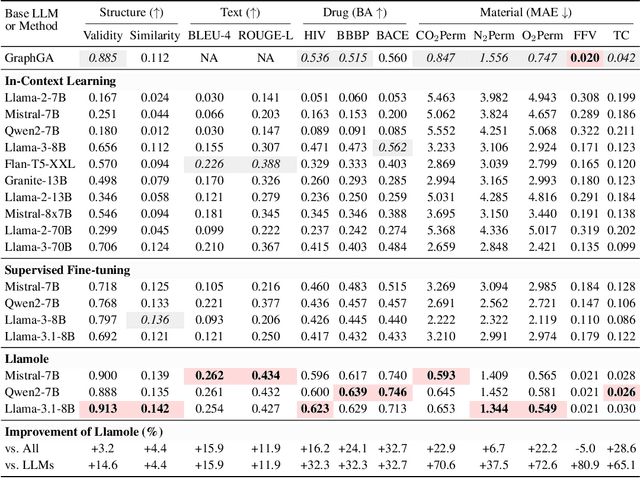
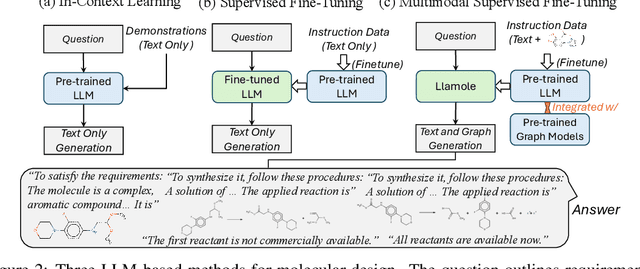

Abstract:While large language models (LLMs) have integrated images, adapting them to graphs remains challenging, limiting their applications in materials and drug design. This difficulty stems from the need for coherent autoregressive generation across texts and graphs. To address this, we introduce Llamole, the first multimodal LLM capable of interleaved text and graph generation, enabling molecular inverse design with retrosynthetic planning. Llamole integrates a base LLM with the Graph Diffusion Transformer and Graph Neural Networks for multi-conditional molecular generation and reaction inference within texts, while the LLM, with enhanced molecular understanding, flexibly controls activation among the different graph modules. Additionally, Llamole integrates A* search with LLM-based cost functions for efficient retrosynthetic planning. We create benchmarking datasets and conduct extensive experiments to evaluate Llamole against in-context learning and supervised fine-tuning. Llamole significantly outperforms 14 adapted LLMs across 12 metrics for controllable molecular design and retrosynthetic planning.
Learning Object Properties Using Robot Proprioception via Differentiable Robot-Object Interaction
Oct 04, 2024Abstract:Differentiable simulation has become a powerful tool for system identification. While prior work has focused on identifying robot properties using robot-specific data or object properties using object-specific data, our approach calibrates object properties by using information from the robot, without relying on data from the object itself. Specifically, we utilize robot joint encoder information, which is commonly available in standard robotic systems. Our key observation is that by analyzing the robot's reactions to manipulated objects, we can infer properties of those objects, such as inertia and softness. Leveraging this insight, we develop differentiable simulations of robot-object interactions to inversely identify the properties of the manipulated objects. Our approach relies solely on proprioception -- the robot's internal sensing capabilities -- and does not require external measurement tools or vision-based tracking systems. This general method is applicable to any articulated robot and requires only joint position information. We demonstrate the effectiveness of our method on a low-cost robotic platform, achieving accurate mass and elastic modulus estimations of manipulated objects with just a few seconds of computation on a laptop.
KAN 2.0: Kolmogorov-Arnold Networks Meet Science
Aug 19, 2024Abstract:A major challenge of AI + Science lies in their inherent incompatibility: today's AI is primarily based on connectionism, while science depends on symbolism. To bridge the two worlds, we propose a framework to seamlessly synergize Kolmogorov-Arnold Networks (KANs) and science. The framework highlights KANs' usage for three aspects of scientific discovery: identifying relevant features, revealing modular structures, and discovering symbolic formulas. The synergy is bidirectional: science to KAN (incorporating scientific knowledge into KANs), and KAN to science (extracting scientific insights from KANs). We highlight major new functionalities in the pykan package: (1) MultKAN: KANs with multiplication nodes. (2) kanpiler: a KAN compiler that compiles symbolic formulas into KANs. (3) tree converter: convert KANs (or any neural networks) to tree graphs. Based on these tools, we demonstrate KANs' capability to discover various types of physical laws, including conserved quantities, Lagrangians, symmetries, and constitutive laws.
Lite2Relight: 3D-aware Single Image Portrait Relighting
Jul 15, 2024Abstract:Achieving photorealistic 3D view synthesis and relighting of human portraits is pivotal for advancing AR/VR applications. Existing methodologies in portrait relighting demonstrate substantial limitations in terms of generalization and 3D consistency, coupled with inaccuracies in physically realistic lighting and identity preservation. Furthermore, personalization from a single view is difficult to achieve and often requires multiview images during the testing phase or involves slow optimization processes. This paper introduces Lite2Relight, a novel technique that can predict 3D consistent head poses of portraits while performing physically plausible light editing at interactive speed. Our method uniquely extends the generative capabilities and efficient volumetric representation of EG3D, leveraging a lightstage dataset to implicitly disentangle face reflectance and perform relighting under target HDRI environment maps. By utilizing a pre-trained geometry-aware encoder and a feature alignment module, we map input images into a relightable 3D space, enhancing them with a strong face geometry and reflectance prior. Through extensive quantitative and qualitative evaluations, we show that our method outperforms the state-of-the-art methods in terms of efficacy, photorealism, and practical application. This includes producing 3D-consistent results of the full head, including hair, eyes, and expressions. Lite2Relight paves the way for large-scale adoption of photorealistic portrait editing in various domains, offering a robust, interactive solution to a previously constrained problem. Project page: https://vcai.mpi-inf.mpg.de/projects/Lite2Relight/
Physically Compatible 3D Object Modeling from a Single Image
Jun 03, 2024Abstract:We present a computational framework that transforms single images into 3D physical objects. The visual geometry of a physical object in an image is determined by three orthogonal attributes: mechanical properties, external forces, and rest-shape geometry. Existing single-view 3D reconstruction methods often overlook this underlying composition, presuming rigidity or neglecting external forces. Consequently, the reconstructed objects fail to withstand real-world physical forces, resulting in instability or undesirable deformation -- diverging from their intended designs as depicted in the image. Our optimization framework addresses this by embedding physical compatibility into the reconstruction process. We explicitly decompose the three physical attributes and link them through static equilibrium, which serves as a hard constraint, ensuring that the optimized physical shapes exhibit desired physical behaviors. Evaluations on a dataset collected from Objaverse demonstrate that our framework consistently enhances the physical realism of 3D models over existing methods. The utility of our framework extends to practical applications in dynamic simulations and 3D printing, where adherence to physical compatibility is paramount.
TetSphere Splatting: Representing High-Quality Geometry with Lagrangian Volumetric Meshes
May 30, 2024Abstract:We present TetSphere splatting, an explicit, Lagrangian representation for reconstructing 3D shapes with high-quality geometry. In contrast to conventional object reconstruction methods which predominantly use Eulerian representations, including both neural implicit (e.g., NeRF, NeuS) and explicit representations (e.g., DMTet), and often struggle with high computational demands and suboptimal mesh quality, TetSphere splatting utilizes an underused but highly effective geometric primitive -- tetrahedral meshes. This approach directly yields superior mesh quality without relying on neural networks or post-processing. It deforms multiple initial tetrahedral spheres to accurately reconstruct the 3D shape through a combination of differentiable rendering and geometric energy optimization, resulting in significant computational efficiency. Serving as a robust and versatile geometry representation, Tet-Sphere splatting seamlessly integrates into diverse applications, including single-view 3D reconstruction, image-/text-to-3D content generation. Experimental results demonstrate that TetSphere splatting outperforms existing representations, delivering faster optimization speed, enhanced mesh quality, and reliable preservation of thin structures.
Neural Fluidic System Design and Control with Differentiable Simulation
May 22, 2024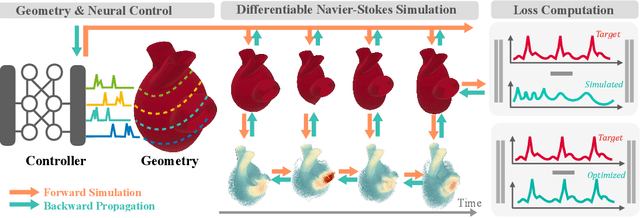
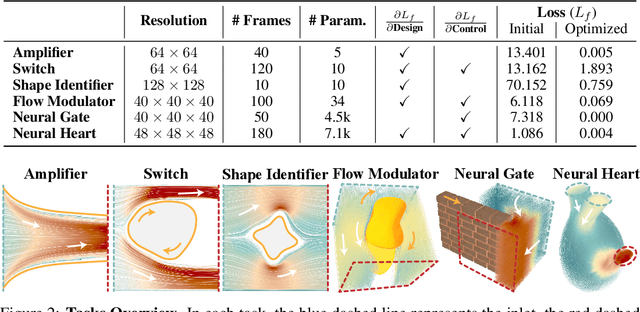

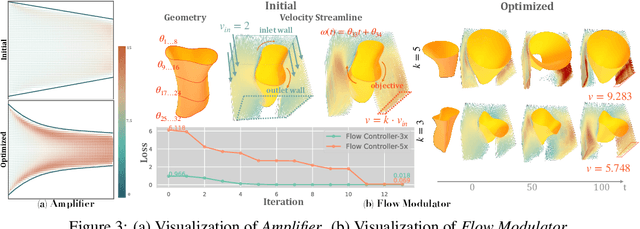
Abstract:We present a novel framework to explore neural control and design of complex fluidic systems with dynamic solid boundaries. Our system features a fast differentiable Navier-Stokes solver with solid-fluid interface handling, a low-dimensional differentiable parametric geometry representation, a control-shape co-design algorithm, and gym-like simulation environments to facilitate various fluidic control design applications. Additionally, we present a benchmark of design, control, and learning tasks on high-fidelity, high-resolution dynamic fluid environments that pose challenges for existing differentiable fluid simulators. These tasks include designing the control of artificial hearts, identifying robotic end-effector shapes, and controlling a fluid gate. By seamlessly incorporating our differentiable fluid simulator into a learning framework, we demonstrate successful design, control, and learning results that surpass gradient-free solutions in these benchmark tasks.
LLM and Simulation as Bilevel Optimizers: A New Paradigm to Advance Physical Scientific Discovery
May 16, 2024Abstract:Large Language Models have recently gained significant attention in scientific discovery for their extensive knowledge and advanced reasoning capabilities. However, they encounter challenges in effectively simulating observational feedback and grounding it with language to propel advancements in physical scientific discovery. Conversely, human scientists undertake scientific discovery by formulating hypotheses, conducting experiments, and revising theories through observational analysis. Inspired by this, we propose to enhance the knowledge-driven, abstract reasoning abilities of LLMs with the computational strength of simulations. We introduce Scientific Generative Agent (SGA), a bilevel optimization framework: LLMs act as knowledgeable and versatile thinkers, proposing scientific hypotheses and reason about discrete components, such as physics equations or molecule structures; meanwhile, simulations function as experimental platforms, providing observational feedback and optimizing via differentiability for continuous parts, such as physical parameters. We conduct extensive experiments to demonstrate our framework's efficacy in constitutive law discovery and molecular design, unveiling novel solutions that differ from conventional human expectations yet remain coherent upon analysis.
 Add to Chrome
Add to Chrome Add to Firefox
Add to Firefox Add to Edge
Add to Edge